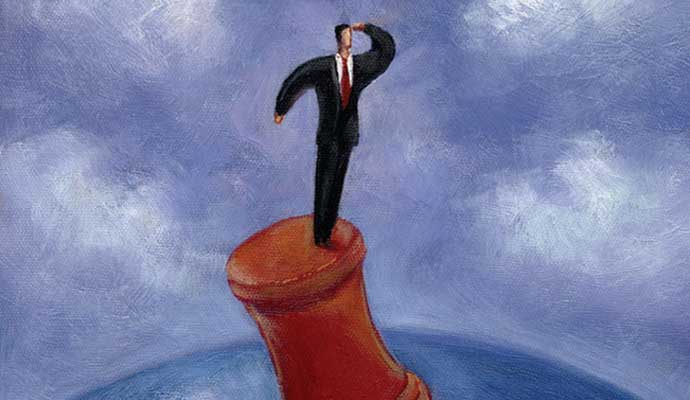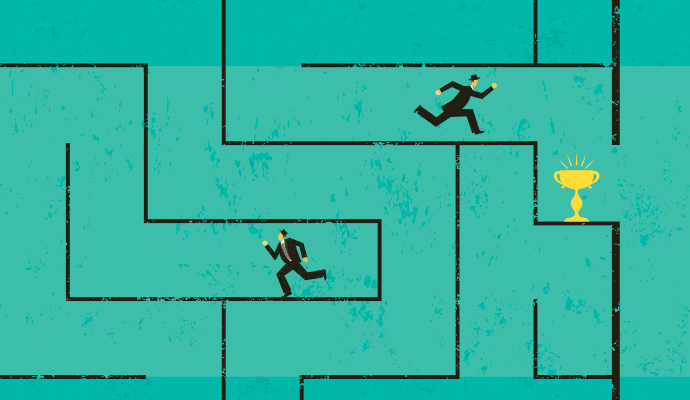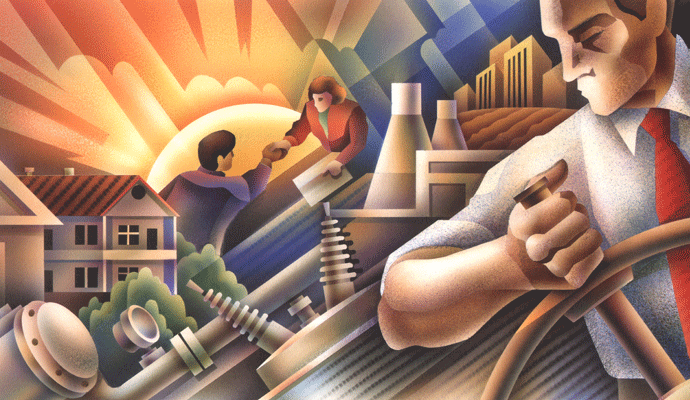Learning to Lead Creatively
It is not enough to say that leadership in today's turbulent corporate environment is an art. Our research shows that managers can become better leaders if they literally take up the artist's pencil and the poet's pen, at least for a little while, to learn how to tap into creative skills that too often lie dormant.
The roiling business world, filled with complex problems without easy answers, demands leadership that is creative and contagious, capable of inspiring and sustaining creativity throughout an organization. Yet training in the management of innovation has either been an afterthought or has been confined to executives working in research and development, an area that is often seen as creativity's only natural home.
We believe it is critically important to expand the inherent competencies of managers -- in all parts of an organization -- for creativity and innovative thinking. And in a new course at the Center for Creative Leadership, we have seen how managers can do this by restoring their underutilized esthetic sensibilities for intuition, feeling and imagination. The trick is being exposed to a variety of artistic methods.
During the course, called "Leading Creatively," executives learn to draw, pencil on paper, from nature as well as from their feelings and intuitions. They create and interpret poems, stories, music, collages and dreams, using these as media to explore their own unique situations. And they share their artistic products and insights with others, accepting criticism and offering some, too.
One objective of the program is to help participants develop R-mode thinking -- more popularly known as right-brain thinking -- where the undervalued intuitive, imaginative and human skills reside. The goal is to offer more of a counterbalance to their already well-developed L-mode skills -- the rational, analytical, numeric and verbal capacities more typically sought in today's business managers. A better mix from both sides is needed for effective leadership of modern organizations.
For example, we worked with a team from a company that was seeking to resolve a longstanding product variability problem in a polymer manufacturing operation.The team was a cross-functional group of key managers. They viewed their task initially as an essentially technical problem, to be solved by refinement of the manufacturing process or by the invention of a new polymer.
Their first steps were rational-analytical -- collecting and analyzing more and more data. But the application of the esthetic viewpoint led to a shift in their approach.The perceived nature of the challenge was transformed from a purely technical framework to something more complex. As they drew abstract pictures of their situation, and told metaphorical stories and shared their dreams about it, they were able to reframe the issue to embrace previously unperceived sources of the variability problem.
This new approach enabled the team members to see how the problem was ingrained in the culture and politics of their company. Throughout the organization, fear and anxiety about the potential upheavals involved were getting in the way of finding a solution. Some employees feared that if the problem were solved, they and others might be laid off because there would be less need for people focused on monitoring or reworking defective products. Differences in perspectives and assumptions within the team also suddenly became apparent -- as did critical aspects of the situation that had been overlooked. Once the team perceived and articulated these complexities in detail, with appropriate perspectives and meanings, it was able to organize a much more comprehensive and effective approach to the problem.
The following are some of the esthetic competencies we have identified that are crucial to this kind of leadership turnaround.
Noticing. Noticing is about paying close attention to various textures, facets and meanings, at deeper and deeper levels. By this we mean slowing down and taking in more of an image, a scene or a situation. The idea is to learn to temporarily suspend sensory shortcuts that can lead to "snap" judgments, like visually "surfing" over the many elements of a particular scene. Instead, by lingering over detail, complexity and drama, new meanings emerge. And that allows complicated issues to be reframed and addressed more effectively.
Subtle representation. While noticing is about paying attention, subtle representation concerns the ability to portray what has been noticed with nuance, detail and accuracy. Drawing requires close coordination between observing and producing. It helps develop an eye for detail, for the relationships among details and for the surrounding context. Drawing enables us to be conscious of when and how much we employ symbolic shortcuts in representing reality and it requires us to put aside such shortcuts when appropriate.
Fluid perspective. This concept is based on the idea that appearance depends upon point of view, and that appearances change with time. Multiple artistic renderings from different points of view over time may draw out an essence of what is observed. In the same way, a dynamic process must be observed from a variety of perspectives over time for an executive to be aware that a process is even occurring. We ask people in teams to create images of their complex situations from different perspectives, over time. This process involves pencil and paper drawings -- (Abstract) representations of the situations drawn from the mind's eye, a method developed by artist and researcher Betty Edwards, author of "Drawing on the Right Side of the Brain." The ensuing dialogue to interpret the drawings builds shared knowledge out of these various renditions, and occasionally sparks a new, unifying point of view. We see this as an advance over more traditional stances on perspective, including the idea that diverse points of view are simply alternative opinions.
Personalizing work. Work life usually requires that people leave their avocations at home. Yet most people, if they exercise their esthetic competencies, do so through their avocations, interests and hobbies. We suggest that people might exhibit more creative leadership through personalizing work: allowing their artistic gifts to spill over into their jobs, thus bringing more of their personal knowledge and experience to bear on the complexities of work life. One person told us how his interests in interior design, music and theater applied to his work: how he decorated his office to reflect his tastes and interests and to be engaging to visitors. He was able to see himself and his co-workers as actors in a drama, and thus understand and engage the flow of social events. "Theater" became a powerful personal metaphor for him, even at work.
Skeptical inquiry. The disciplined use of intuition and imagination to address complex challenges requires a role for thoughtful skepticism. Skeptical inquiry is about cultivating doubt, uncertainty, disagreement, criticism and alternative ideas in a way that adds insight and energy to a collaborative process. Such inquiry, through drawing and analyzing the work of master painters, includes framing and asking powerful questions that open up hidden areas for exploration. This skill is in some ways a reconciliation between left brain and right brain thinking. It permits people to retain their critical analytical thinking while developing and applying "what if?" R-mode thinking. The payoff is to perceive new aspects of a problem and to produce imaginative new solutions.
Star model. To foster creativity in a group, it is essential for members to know how to find shared meaning in each other's efforts. We use a method called the star model. Members of a discussion group represent points of a star. A member offers something, say a dream and her interpretation of it, to the center of the star. Other members take the dream as if, for a moment, it were their own -- "If this were my dream ..." -- and offer their own interpretation. At the end of this process, the originator of the dream reclaims it and the right to interpret it for herself -- although the others now can claim their own experiences of the dream. Creative tension is thus channeled radially between each member and the idea in the center, rather than directly between the members. This procedure helps the group to respectfully preserve, explore and reconcile various viewpoints.
Portraying paradoxes, conflicts and the unknown. A complex challenge typically contains tensions, apparently incompatible parts and even some mysteries. The goal is to notice and then accurately represent such elements without prematurely discarding them. Representing the problem through art-making activities over time allows images and ideas to evolve and shows development or movement among the elements. Going deeper, and getting at assumptions and underlying forces, is part of this evolution. For example, in the case of the team struggling with the product variability problem, the members explored an image that recurred within their drawings, which for them reframed the problem as one that would not be dramatically eliminated but would improve over time. This reduced the self-imposed pressure for the team to come up with a startling breakthrough. It also gave them freedom, along with new language and images, to explore and understand variability in less simplistic, more systemic and more imaginative ways.
Facility with metaphor. Facility with metaphor is crucial to the construction of meaning. Metaphor is always a part of creating ideas. The identity of an organization is frequently contained in stories told by its members, typically filled with rich metaphors. Likewise, individuals construct their personal identities out of stories; the root metaphor of a person's identity is a driving force in his or her leadership role. The use of metaphor, in the writing of stories about their individual issues, provides participants with an emotional and intellectual haven. This enables them to go deeper into their leadership challenges and produce imaginative insights toward their resolution. Indeed, metaphor may be a key vehicle for integrating L-mode and R-mode understanding. It takes a certain kind of competence, and practice, to use metaphors to create new meaning for individuals and organizations. Too often metaphors become superficial, stale or inaccurate. By contrast, we encourage a freer, albeit self-censored, kind of writing that will tap into an individual's deeper concerns.
By tapping into those concerns, with metaphors and the other tools of the artist, managers can release not just their own creative powers but also the creativity of their teams. And if enough of them do that, the whole company will feel the change. ![]()




